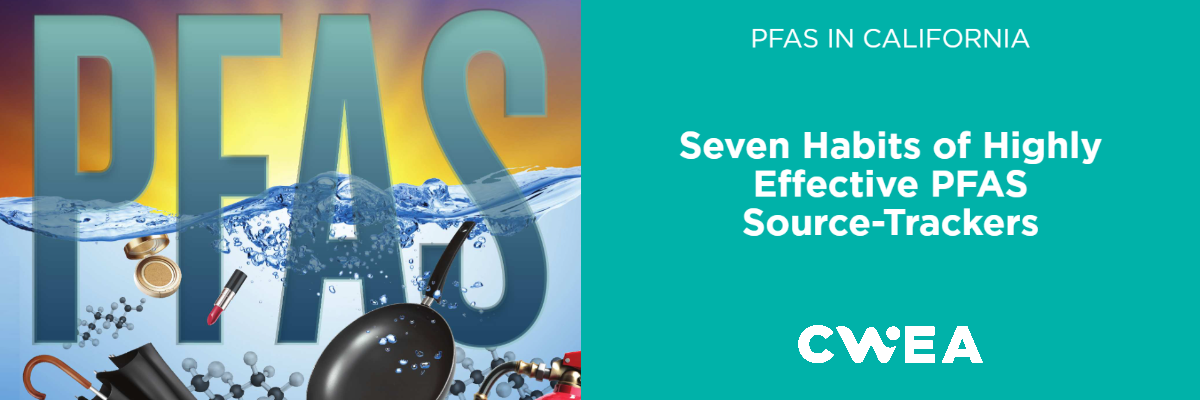
Seven Habits of Highly Effective PFAS Source-Trackers - Live Webinar
Recorded On: 06/21/2023
- Registration Closed

Member fee: $25.00
Non-Member fee: $35.00
1.2 Contact Hours towards CWEA Certifications: ECI & LAB
Introduction
This presentation will share results of The Water Research Foundation’s (WRF’s) Project #5082: Investigation of Alternative Management Strategies to Prevent PFAS from Entering Drinking Water Supplies and Wastewater.
PFAS are a class of chemicals notorious for their persistence, bioaccumulation, and toxicity. Two well-known PFAS are perfluorooctanoic acid (PFOA) and perfluorosulfonic acid (PFOS). Based on finished water samples collected for the third Unregulated Contaminant Monitoring Rule (UCMR3), 66 water systems serving an estimated six million US residents had PFOA and PFOS above the EPA’s 2016 health advisory level (HAL) of 70 ng/L combined. Twelve systems in Florida had PFAS detections in UCMR3.
More systems will likely have detectable PFOA or PFOS in the upcoming UCMR5 (2023-2025), which will use more precise methods. Any detectable PFOA or PFOS would be above these compounds’ new EPA health advisory levels (HALs): 0.004 ng/L and 0.02 ng/L, respectively. The EPA is planning PFOA & PFOS MCLs as well as HALs for more PFAS. Utilities are bracing for these upcoming developments.
The technologies granular activated carbon, ion exchange, and reverse osmosis are effective for PFAS removal, but expensive. So, more research and policy emphasis are needed on preventing PFAS from entering water in the first place.
Project Description
The goal of this project was to develop actionable strategies that would lead to effective management of PFAS sources for utilities. This project included surveys about utilities’ experiences in monitoring, tracking, and mitigating PFAS. It filled data gaps about the relative importance of different PFAS sources across wastewater, surface water, and groundwater. This included thorough investigations of two watersheds to calibrate a nationwide PFAS model based on point sources and de facto reuse. The information collected during the study culminated in a guidance document about how utilities can best identify and eliminate PFAS sources.
Findings
A key lesson learned from utility case studies include the importance of collaboration among utilities, universities, and state governments when working to find PFAS sources. State databases were mined for statistics on PFAS occurrence and sources in groundwater. Landfills were the most frequent source of PFAS to groundwater in multiple databases. In surface water, the presence of even less than one percent wastewater effluent could cause PFOA to exceed its new HAL. However, it would take over 90% wastewater effluent or a major industrial source to exceed any enforceable state MCLs. The guidance developed through this project recognizes that source identification and mitigation are utilities’ “first line of defense” against PFAS. It provides specific and actionable recommendations to support this approach.
Photo illustration by Kelman Publishing (c) CWEA

Kyle Thompson, PhD, PE
Reuse Lead Technologist / National PFAS Lead
Carollo Engineers, Inc.
Kyle Thompson is National PFAS Lead and a Reuse Lead Technologist at Carollo Engineers. His areas of expertise include PFAS, potable reuse, and machine learning. Kyle received his BS in environmental engineering in 2013 from Missouri University of Science & Technology as valedictorian and with honors. He received a Master of Science in Civil Engineering and PhD in Environmental Engineering from the University of Colorado Boulder. Kyle previously worked as postdoctoral researcher at the Southern Nevada Water Authority. Kyle is a registered Professional Engineer in the state of Nevada.
Registrants who view the live webinar to see the slides and hear the audio and then enter the correct attention check code (directions below) will receive 1.2 contact hours towards CWEA's certifications: ECI & LAB
To receive your contact hours for viewing the live webinar, please note the two (2) different attention check codes that will be displayed at two different points during the webinar in the top left or right corner of the presentation for approximately 90 seconds. Please enter these codes as 1st attention check code – 2nd attention check code (XXXX-XXXX) in the Attention Check Code component under the "Contents" tab.
Please note, all user activity of CWEA certification holders on the Online Wastewater Education Network is subject to the CWEA Code of Ethics standards for professional conduct and ethics. Certification holders should receive credit for a training only once within the same contact hour period. Any attempt to undermine the certification process may be subject to ethics procedures and possible sanctions. It is not possible to receive contact hours for both attending the live webinar and viewing the recording.
Once you have entered the correct attendance check codes, you will be able to create and download an electronic certificate of completion under the "Contents" tab.

